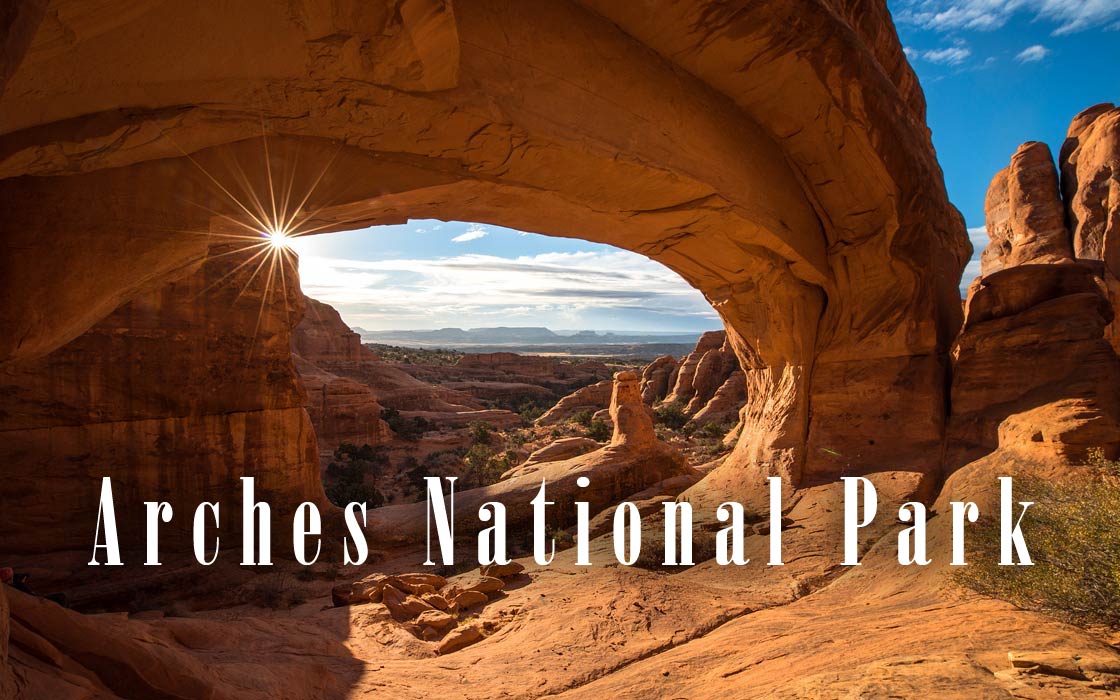Discovering the Natural Wonders of Arches National Park
Nestled amidst the striking red rock landscapes of Utah lies a natural wonderland unlike any other, Arches National Park. Here, over 2,000 natural sandstone arches stand proudly, testimony to the unyielding power of time and geologic forces. For millions of years, wind and water have sculpted the red rock formations, creating an otherworldly landscape of towering spires, gravity-defying balanced rocks, and other incredible geological formations.
But Arches National Park is more than just a geological wonder. It’s a paradise for nature lovers, outdoor adventurers, and anyone seeking a connection with the natural world. Hiking, biking, rock climbing, and stargazing are just a few of the activities that visitors can experience in this beautiful desert oasis. From easy nature walks to challenging backcountry treks, there’s a trail for everyone to explore.
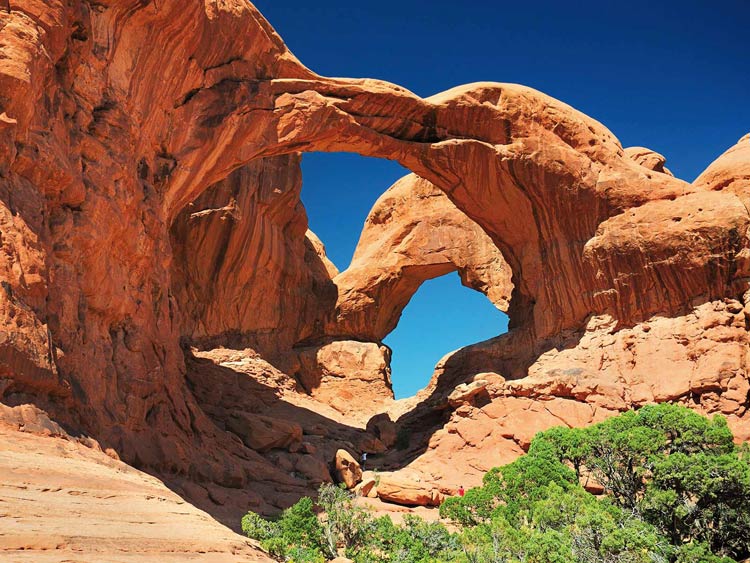
Journey Through Time: Geology and History of Arches National Park
And it’s not just the geology that makes Arches National Park special. The park is home to a unique and diverse ecosystem, from desert wildflowers to bighorn sheep and golden eagles. It’s a place where visitors can disconnect from the hustle and bustle of modern life and immerse themselves in the beauty and tranquility of nature.
Whether you’re an outdoor enthusiast, a history buff, or simply someone looking for a breathtaking escape, Arches National Park is a destination you won’t want to miss. Its surreal landscapes, stunning colors, and hidden treasures make it a true gem of the American West, a natural wonderland that will leave you awestruck and inspired.
Arches National Park is a protected area in eastern Utah, United States, known for its over 2,000 natural sandstone arches. The park covers an area of approximately 76,519 hectares (119 square miles). The park is located near Moab, Utah, and is a popular destination for hiking, camping, and sightseeing. Elevations in the park range from 1,320 meters (4,327 feet) at the Visitor Center to 1,653 meters (5,435 feet) at Elephant Butte.

Location
Arches National Park is located in the southeastern region of Utah, United States, near the town of Moab. The park is approximately 256 kilometers (159 miles) southeast of Salt Lake City and 320 kilometers (199 miles) southwest of Grand Junction, Colorado.
Basic Facts About Arches National Park
- Arches National Park is a national park located in eastern Utah, United States.
- It covers an area of approximately 76,519 hectares (119 square miles).
- The park is known for its over 2,000 natural sandstone arches, as well as its other unique geological formations, such as balanced rocks, fins, and spires.
- The elevation in the park ranges from 1,320 meters (4,327 feet) at the Visitor Center to 1,653 meters (5,435 feet) at Elephant Butte.
- Arches National Park was established in 1929 and receives over 1.5 million visitors annually.
- The park offers a variety of recreational activities, including hiking, camping, rock climbing, and scenic driving.
- Arches National Park is also home to a variety of wildlife, including rattlesnakes, desert bighorn sheep, and many species of birds.
- The geology of the park is dominated by Entrada Sandstone, which was formed over 150 million years ago and is responsible for the creation of the park’s iconic arches.
- The climate in the park is classified as a hot desert climate, with temperatures that can reach up to 40°C (104°F) in the summer and drop to below freezing in the winter.
- The park has several scenic drives, including the Arches Scenic Drive and the Park Avenue Viewpoint, which offer visitors stunning views of the park’s landscapes and geological formations.
- Some of the most popular hiking trails in the park include the Delicate Arch Trail, the Devil’s Garden Trail, and the Double Arch Trail.
- Arches National Park is open year-round, although some roads and trails may be closed in the winter due to snow and ice.
- The park has several facilities available for visitors, including a campground, picnic areas, and a Visitor Center with exhibits on the park’s geology, wildlife, and cultural history.

History and name of the Park
The Arches National Park is named after the over 2,000 natural sandstone arches found within its boundaries. The area has a rich cultural history, with evidence of human habitation dating back over 10,000 years. The ancestral Puebloans lived in the area for several centuries, and their rock art can still be seen in the park today.
The park was established as a national monument in 1929 and was later redesignated as a national park in 1971. In the decades since its creation, Arches National Park has become one of the most popular tourist destinations in the American Southwest, attracting millions of visitors annually from all over the world.
The park was named for its unique geological features, and its iconic arches have become symbols of the beauty and power of nature. The park’s landscape continues to change and evolve over time, with new arches forming and existing ones collapsing, reminding visitors of the ever-changing nature of our planet.
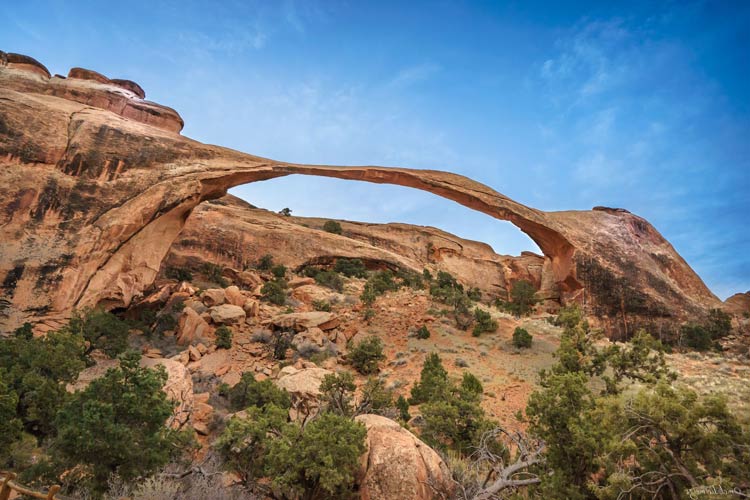
Geography
Arches National Park is located in eastern Utah, United States, near the town of Moab. The park covers an area of approximately 76,519 hectares (119 square miles), and its boundaries include a wide variety of geological formations and landscapes, including high plateaus, sandstone fins, and towering spires.
The park sits on the Colorado Plateau, a large elevated plateau that covers a large part of the American Southwest, and is characterized by its high elevations, arid climate, and diverse geological features.
The park is located in a desert environment, with hot and dry summers and cold and dry winters. Despite the harsh climate, the park is home to a variety of wildlife, including rattlesnakes, desert bighorn sheep, and many species of birds.
Arches National Park is located near several other national parks and protected areas, including Canyonlands National Park, the Glen Canyon National Recreation Area, and the Hovenweep National Monument, making it part of a larger region of protected lands known for its unique landscapes and cultural history.

Features of the park
Arches National Park is known for its unique geological features and stunning landscapes. Some of the park’s most notable features include:
- Natural Arches
The park is named after its over 2,000 natural sandstone arches, which are formed when portions of rock fins erode away, leaving openings or “windows.” Some of the park’s most famous arches include Delicate Arch, Landscape Arch, and Double Arch. - Balanced Rocks
These large, free-standing rocks appear to defy gravity, as they balance on small points or bases. - Fins
Tall, narrow, wall-like formations that rise from the ground. - Spires
Pointed rock formations that rise from the ground. - Petrified Dunes
Remnants of ancient sand dunes that have been preserved and turned to stone. - Scenic Drives
The park has several scenic drives, including the Arches Scenic Drive and the Park Avenue Viewpoint, which offer visitors stunning views of the park’s landscapes and geological formations. - Hiking Trails
The park offers a variety of hiking trails, ranging from easy walks to challenging hikes, that take visitors through the park’s diverse landscapes and past its iconic features. - Wildlife
The park is home to a variety of wildlife, including rattlesnakes, desert bighorn sheep, and many species of birds. - Cultural History
The park has a rich cultural history, with evidence of human habitation dating back over 10,000 years. The ancestral Puebloans lived in the area for several centuries, and their rock art can still be seen in the park today.
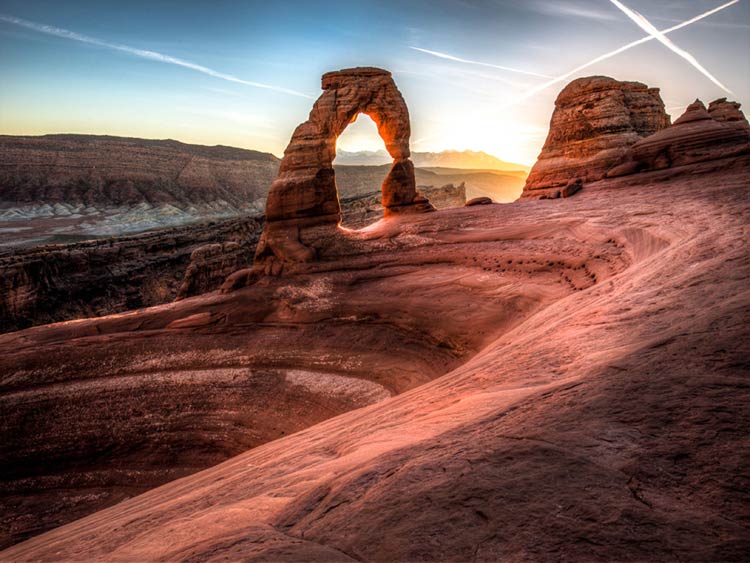
Geology
Arches National Park is known for its unique geological features, including over 2,000 natural sandstone arches. The rock formations in the park are primarily composed of Entrada Sandstone, which was formed over 150 million years ago during the Jurassic period.
The arches in the park are formed when portions of rock fins erode away, leaving openings or “windows.” This process occurs over a long period of time and is caused by several factors, including wind, rain, and freeze-thaw cycles. The opening eventually becomes an arch when the rock surrounding the opening is removed by erosion.
In addition to the arches, the park also features other unique geological formations, such as balanced rocks, fins, spires, and petrified dunes. These formations are also made of Entrada Sandstone and are the result of millions of years of erosion and weathering.
The geology of the park continues to evolve over time, with new arches forming and existing ones collapsing, reminding visitors of the ever-changing nature of our planet. The park’s geological features are a testament to the power of wind, water, and time, and they offer a unique and awe-inspiring look into the geological history of our planet.
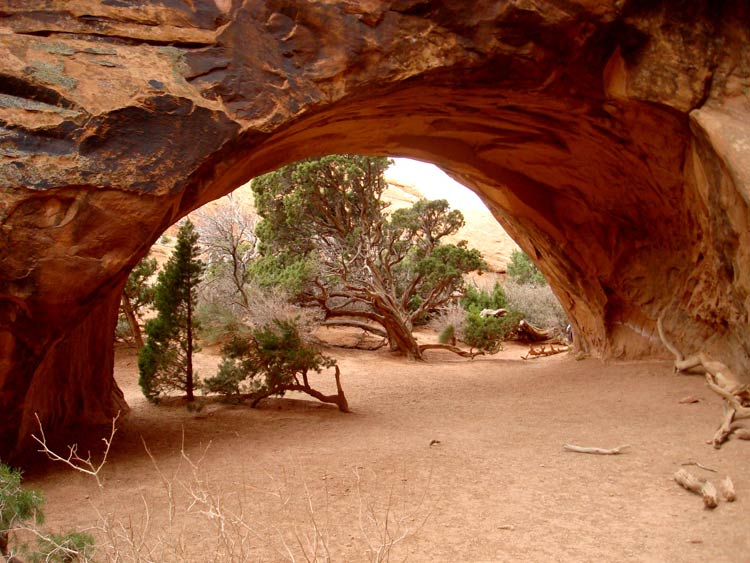
Climate
Arches National Park is located in a desert environment, with hot and dry summers and cold and dry winters. The park’s climate is characterized by low precipitation, high evaporation, and extreme temperature swings.
During the summer months, temperatures in the park can reach up to 40°C (104°F) and higher, while nighttime temperatures can drop to below freezing. Winter temperatures are much milder, with daytime temperatures averaging around 10°C (50°F) and nighttime temperatures dropping to below freezing.
Annual precipitation in the park is low, with most of the rain falling in the summer months. Snowfall is rare but can occur during the winter months. Despite the harsh climate, the park is home to a variety of plant and animal species that have adapted to the unique conditions of the desert environment.

Flora in Arches National Park
Arches National Park is located in a desert environment, and as a result, its vegetation is adapted to survive in harsh conditions with limited water. Despite the challenging growing conditions, the park is home to a variety of plant species, including:
- Shrubs
Shrubs are a common sight in the park, and they provide essential habitat and food for wildlife. Some of the most common shrub species in the park include blackbrush (Coleogyne ramosissima), Utah juniper (Juniperus osteosperma), and mountain mahogany (Cercocarpus ledifolius). - Cacti
Cacti are well adapted to the desert climate and are a common sight in the park. Some of the cacti species found in the park include the prickly pear cactus (Opuntia polyacantha), the barrel cactus (Ferocactus cylindraceus), and the cholla cactus (Cylindropuntia sp.). - Wildflowers
Despite the harsh conditions, the park is home to a variety of wildflowers, which bloom in the spring and early summer. Some of the most common wildflowers in the park include desert parsley (Lomatium utriculatum), Indian paintbrush (Castilleja sp.), and desert bluebells (Phacelia sp.). - Grasses
Grasses are an important part of the park’s vegetation, providing food and habitat for wildlife. Some of the grass species found in the park include blue grama (Bouteloua gracilis) and Indian ricegrass (Oryzopsis hymenoides). - Trees
Trees are less common in the park, but some species can be found in riparian areas and near the park’s water sources. Some of the tree species found in the park include the cottonwood (Populus fremontii) and the willow (Salix sp.).
The park’s vegetation is an important part of its ecosystem and provides essential habitat and food for the park’s wildlife. Visitors are encouraged to leave the park’s plants and wildlife undisturbed to help preserve the park’s unique and delicate ecosystem.

Fauna in Arches National Park
Arches National Park is home to a variety of wildlife species, including:
- Mammals
Some of the mammal species found in the park include the black-tailed jackrabbit (Lepus californicus), the desert cottontail (Sylvilagus auduboni), and the pronghorn antelope (Antilocapra americana). The park is also home to several species of bats, including the little brown bat (Myotis lucifugus) and the big brown bat (Eptesicus fuscus). - Birds
The park is a popular destination for birders and is home to a variety of bird species, including the turkey vulture (Cathartes aura), the rock wren (Salpinctes obsoletus), and the canyon wren (Catherpes mexicanus). The park is also home to several species of owls, including the great horned owl (Bubo virginianus) and the burrowing owl (Athene cunicularia). - Reptiles
The park is home to several species of reptiles, including the desert horned lizard (Phrynosoma platyrhinos), the western collared lizard (Crotaphytus collaris), and the desert tortoise (Gopherus agassizii). - Amphibians
Amphibians are less common in the park, but some species can be found near the park’s water sources. Some of the amphibian species found in the park include the canyon treefrog (Hyla arenicolor) and the Great Basin spadefoot toad (Spea intermontana). - Insects
The park is home to a variety of insect species, including bees, butterflies, and beetles. Some of the insect species found in the park include the monarch butterfly (Danaus plexippus), the honeybee (Apis mellifera), and the ladybug (Coccinellidae).
The park’s wildlife is an important part of its ecosystem and plays a crucial role in the park’s food web. Visitors are encouraged to leave the park’s wildlife undisturbed and to follow park regulations to help preserve the park’s unique and delicate ecosystem.

Tourism and tourist main attractions in the park
Arches National Park is a popular tourist destination, attracting visitors from all over the world to see its unique geological formations and natural beauty. Some of the main attractions in the park include:
- Arches
The park is named after its numerous natural stone arches, which are formed by the erosion of sandstone over time. Some of the most famous arches in the park include Delicate Arch, Landscape Arch, and Double Arch. - Fiery Furnace
The Fiery Furnace is a labyrinth of narrow canyons and towering sandstone fins. Visitors can explore the area on guided tours or with a park permit. - Balanced Rock
Balanced Rock is a massive sandstone rock formation that appears to be precariously balanced on a narrow base. Visitors can view the formation from a nearby hiking trail. - Petrified Dunes
The Petrified Dunes are a unique geological feature in the park that formed from ancient sand dunes that have since been fossilized. Visitors can view the dunes from a nearby hiking trail. - Windows Section
The Windows Section is a popular destination in the park that features several large arches and other rock formations, including the famous North and South Window Arches.
In addition to these main attractions, the park also offers a variety of recreational activities, including hiking, camping, rock climbing, and scenic drives. Visitors are encouraged to follow park regulations and to respect the park’s delicate ecosystem to help preserve its natural beauty for future generations.
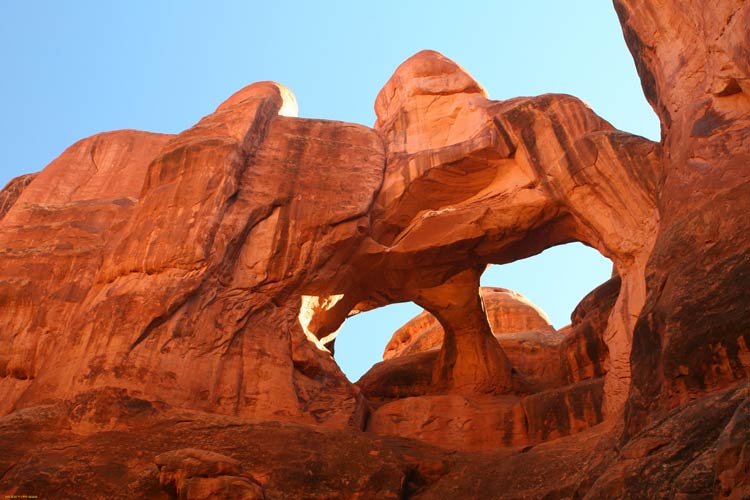
How To Reach To Arches National Park?
Arches National Park is located in southeastern Utah and can be accessed by several means of transportation.
- By car
The most convenient way to reach Arches National Park is by car. The park is located about 5 miles (8 km) north of Moab, Utah, along Highway 191. If you’re driving from Salt Lake City, it takes about 4.5 hours to reach the park, and from Denver, it takes about 6.5 hours. - By plane
The closest airport to Arches National Park is Canyonlands Field (CNY), located in Moab, Utah, about 5 miles (8 km) from the park. The airport is served by daily flights from Denver and Salt Lake City. Alternatively, you can also fly into Salt Lake City International Airport (SLC) or Grand Junction Regional Airport (GJT) and drive to the park. - By bus
Several bus companies offer transportation to Moab, Utah, from major cities in the United States. Once you reach Moab, you can take a taxi or shuttle to Arches National Park. - By train
Amtrak’s California Zephyr stops in Grand Junction, Colorado, about 50 miles (80 km) from Arches National Park. From Grand Junction, you can rent a car or take a shuttle to the park. - By bike
For the more adventurous travelers, it’s possible to bike to Arches National Park along scenic highway 128.
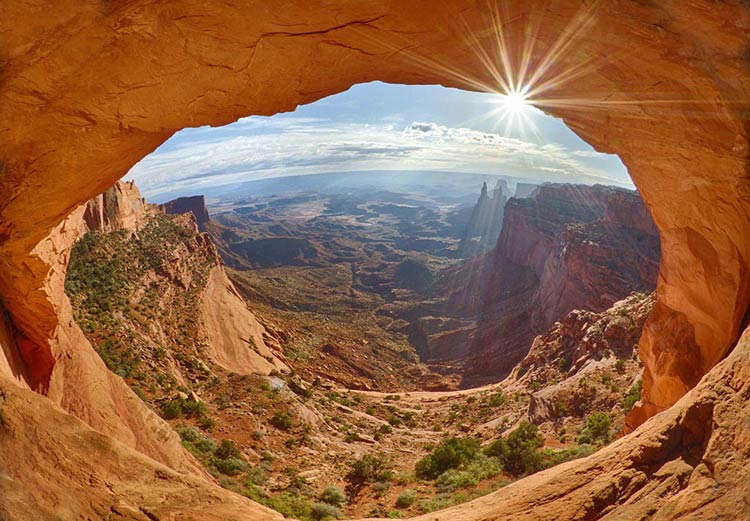
Best Time To Visit Arches National Park
The best time to visit Arches National Park depends on your preferences and what you want to do in the park. The peak tourist season is from March to October when the weather is mild, and the park offers many outdoor activities. However, the park can be very crowded during this time, and temperatures can be hot during the summer months, with temperatures frequently exceeding 100°F (38°C).
If you prefer to avoid crowds and enjoy cooler temperatures, then the best time to visit is during the offseason, from November to February. Although temperatures can be cold, there are still plenty of things to see and do in the park, such as hiking, wildlife viewing, and stargazing. Additionally, you’ll have a better chance of seeing winter phenomena like snow-covered arches and icicles.
Overall, the best time to visit Arches National Park is in the spring (April to May) and fall (September to October) when temperatures are moderate, and there are fewer crowds. However, if you plan to visit during the peak season, be sure to book your accommodations and tours well in advance.
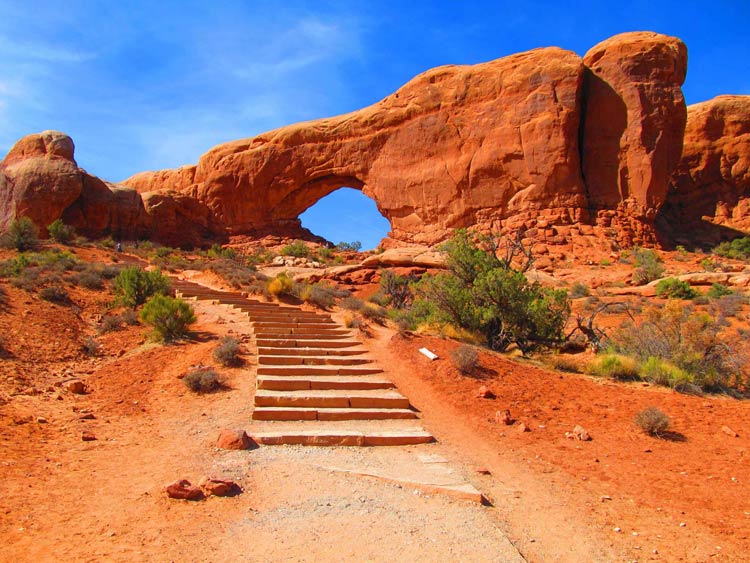
Arches National Park in numbers
- Year established: Arches National Park was established on April 12, 1929.
- Park size: The park covers an area of approximately 76,359 acres (31,037 hectares).
- Elevation: The park ranges in elevation from 4,085 feet (1,245 meters) at the Visitor Center to 5,653 feet (1,723 meters) at Elephant Butte.
- Number of arches: The park is home to over 2,000 natural stone arches, making it one of the largest concentrations of natural arches in the world.
- Visitors: The park attracts over 1.5 million visitors each year.
- Campgrounds: The park has two campgrounds, the Devil’s Garden Campground and the Arches Campground, with a total of 118 campsites.
- Hiking trails: The park has over 20 miles (32 kilometers) of hiking trails, ranging from easy nature walks to challenging backcountry hikes.
- Roadways: The park has a total of 18 miles (29 kilometers) of roadway, including the 18-mile (29-kilometer) Scenic Drive, which offers visitors views of many of the park’s main attractions.
These numbers give a general idea of the size and popularity of Arches National Park and highlight some of its most notable features.
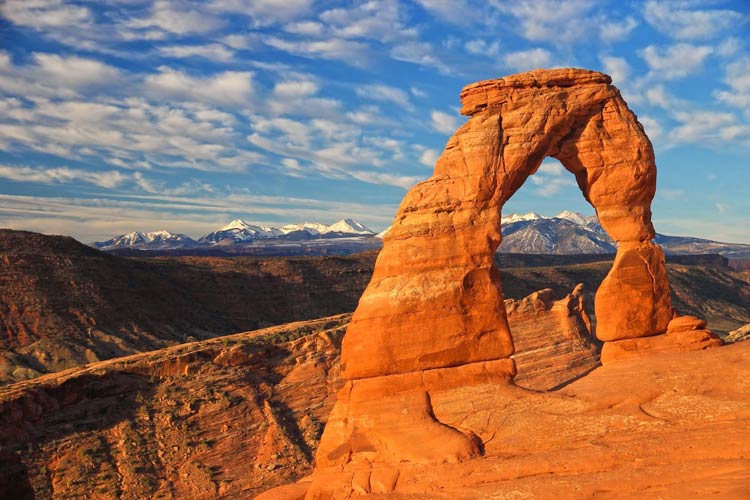
Interesting facts about Arches National Park
- Natural Arches
The natural arches in the park are formed from sandstone rock that has been shaped by wind, water, and freeze-thaw cycles over millions of years. - Rock Color
The sandstone rock in the park is known for its distinctive red color, which is caused by iron oxide in the rock. - Rare Species
Arches National Park is home to several rare species of plants and animals that are found nowhere else in the world. For example, the giant chain fern (Woodwardia fimbriata) and leatherweed (Croton pottsii) are two plants that are unique to the park. - Dark Skies
Arches National Park is designated as a “Dark Sky Park” by the International Dark-Sky Association, which means that it has some of the darkest skies in the United States. This makes it an ideal location for stargazing and observing celestial events like meteor showers and eclipses. - Oldest Arche
The park is home to the oldest recorded arch in the world, named the “Rainbow Bridge.” It is estimated to be over 200 million years old. - Rock Climbing
Arches National Park is a popular destination for rock climbers, who come to scale its towering sandstone formations. However, climbing is only allowed in designated areas of the park and is subject to strict regulations to protect the delicate rock formations and ecosystems. - Landscapes
The park features a wide range of landscapes, including towering fins, towering spires, narrow canyons, and massive sandstone formations.
These facts highlight the unique and diverse features of Arches National Park and help to explain why it is such a popular destination for visitors from all over the world.
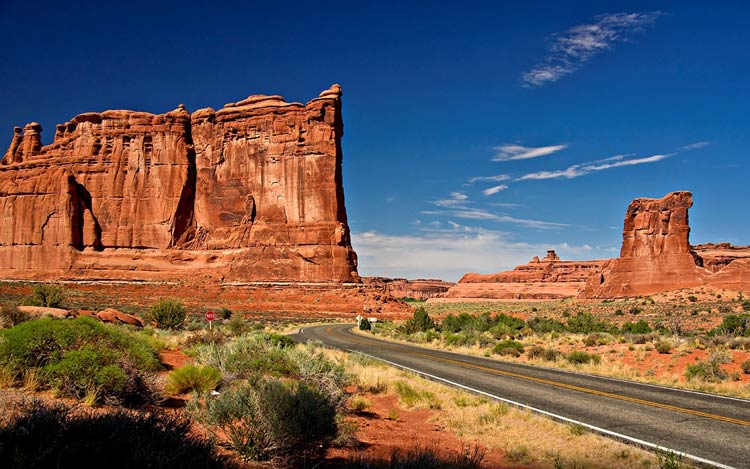
Q&A (questions and answers) about Arches National Park
Q: What is Arches National Park?
A: Arches National Park is a protected area located in southeastern Utah, USA. The park is famous for its natural stone arches and other sandstone formations, which have been shaped by wind, water, and freeze-thaw cycles over millions of years.
Q: When was Arches National Park established?
A: Arches National Park was established on April 12, 1929.
Q: How large is Arches National Park?
A: The park covers an area of approximately 76,359 acres (31,037 hectares).
Q: What is the elevation range in Arches National Park?
A: The park ranges in elevation from 4,085 feet (1,245 meters) at the Visitor Center to 5,653 feet (1,723 meters) at Elephant Butte.
Q: How many natural arches are in Arches National Park?
A: The park is home to over 2,000 natural stone arches, making it one of the largest concentrations of natural arches in the world.
Q: How many visitors does Arches National Park receive each year?
A: The park attracts over 1.5 million visitors each year.
Q: What type of fauna can be found in Arches National Park?
A: Arches National Park is home to a variety of fauna, including mule deer, desert bighorn sheep, pronghorns, coyotes, and many species of birds, reptiles, and small mammals.
Q: What is the Delicate Arch?
A: The Delicate Arch is one of the most famous natural arches in Arches National Park. It is a towering freestanding arch that stands at over 50 feet (15 meters) tall and is a popular destination for visitors to the park.
Q: What is the significance of Arches National Park as a Dark Sky Park?
A: Arches National Park is designated as a “Dark Sky Park” by the International Dark-Sky Association, which means that it has some of the darkest skies in the United States. This makes it an ideal location for stargazing and observing celestial events like meteor showers and eclipses.


